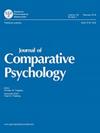灵长类动物共同表征和合作灵活性的起源:与普通狨猴(Callithrix jacchus)、棕色卷尾猴(Sapajus apella)和东京猕猴(Macaca tonkeana)的比较研究。
IF 1.1
4区 心理学
Q4 BEHAVIORAL SCIENCES
引用次数: 5
摘要
人类的联合行动通常是由不仅代表自己的任务和行为而且代表同伴的倾向而促成的。然而,在某些情况下,例如在联合Simon任务中,共同表示可能会造成干扰和阻碍,而不是促进联合执行。因此,一个称职的合作者也应该能够灵活地抑制共同代表,如果这有利于合作的成功。为了研究共同表征的进化起源,以及必要时抑制共同表征的合作灵活性,我们在联合Simon任务中测试了棕色卷尾猴和东京猕猴,并将它们与之前测试的狨猴进行了比较。3个物种均存在共代表,但其强度和合作成功率差异较大。合作繁殖的狨猴表现出最弱的共同表征效应,因此合作成功率最高,当需要与同伴协调时,它们是唯一使用相互凝视的狨猴。因此,合作灵活性与大脑大小无关,而与自然界中合作的普遍程度有关。这一结论被注视模式的物种差异所证实,并表明人类合作灵活性的驱动因素不仅仅是认知。(PsycInfo Database Record (c) 2022 APA,版权所有)。本文章由计算机程序翻译,如有差异,请以英文原文为准。
Primate origins of corepresentation and cooperative flexibility: A comparative study with common marmosets (Callithrix jacchus), brown capuchins (Sapajus apella), and Tonkean macaques (Macaca tonkeana).
Human joint action is generally facilitated by the tendency to represent not only one's own task and behavior but also the partner's. Yet, under some conditions, such as in the joint Simon task, corepresentation can cause interference and hampers, rather than facilitates, joint performance. A competent cooperator should thus also be able to flexibly inhibit corepresentation if that is conducive to cooperation success. To investigate the evolutionary origin of corepresentation, as well as the cooperative flexibility to inhibit it when necessary, we tested brown capuchins and Tonkean macaques in the joint Simon task and compared them with the previously tested marmosets. Corepresentation was present in all 3 species, but its strength and the cooperation success varied substantially. The cooperatively breeding marmosets showed the weakest corepresentation effect and, therefore, highest cooperation success, and they were the only ones to use mutual gaze when coordination with the partner was necessary. Cooperative flexibility was therefore not correlated with brain size but with the prevalence of cooperation in nature. This conclusion was corroborated by species differences in gazing patterns and suggests that the drivers of cooperative flexibility in humans were not solely cognitive. (PsycInfo Database Record (c) 2022 APA, all rights reserved).
求助全文
通过发布文献求助,成功后即可免费获取论文全文。
去求助
来源期刊
CiteScore
3.30
自引率
7.10%
发文量
0
审稿时长
>12 weeks
期刊介绍:
The Journal of Comparative Psychology publishes original research from a comparative perspective
on the behavior, cognition, perception, and social relationships of diverse species.

 求助内容:
求助内容: 应助结果提醒方式:
应助结果提醒方式:


